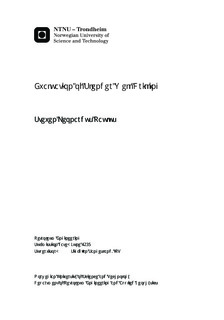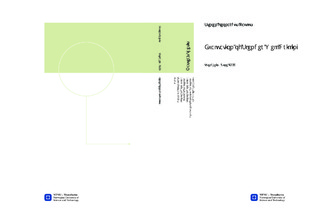| dc.description.abstract | The Slender well concept is one of the methods to reduce drilling time and cost. So, more wells can be drilled to increase the productivity of the field. The concept reduces the casing size on the top section and maintaining the production section of the well to be the same. It allows reducing the size of the riser, blow-out-preventer and well head, tubular and rig-size needed to handle all the equipment. On top of the cost reduction from using smaller equipment, there is also cost reduction from the materials used e.g. volume of drilling muds, cements and steel, etc.There are three Slender Well designs which have been proposed. This thesis analyzes all three designs and compares these with the Standard Conventional design. The Slender Well design proposals are the FMC (medium) design, the SBBU-1 and SBBU-2 design.The analysis in this thesis covers the potential cost savings for the different options. Also the hydraulics of each design based on the flow-rate selection for each hole-size is discussed. The hydraulic modeling provides static and dynamic well pressure that can be used to calculate the radial and tangential stresses present in the borehole.Compared to a standard well, the Slender Well designs show that the cuttings volume can be reduced by 39% for the FMC design, 48% for the SBBU-1 design and 58% for the SBBU-2 design. The mud volume reduction is as much as 31% for the FMC design, 44% for the SBBU-1 design and 46% for the SBBU-2 design. The steel volume (weight) reduction is as much as 12% for the FMC design, 42% for the SBBU-1, 29% for SBBU-1 with tie-back liner and 63% for the SBBU-2 design.The hydraulics study shows that the Slender Well designs have a lower pressure loss because smaller hole-size uses lower flow-rate. However, for the SBBU-1 design with 5-7/8 inch hole in the production section the annulus pressure loss becomes more dominant. The SBBU-1 with the tie-back option has the highest annulus pressure loss. It will have a higher pump pressure during drilling and will limit the flow-rate. The SBBU-2 utilizes liner and creates bigger flow area in the annulus. The annular velocity in the biggest flow area will be very low when drilling the 5-7/8 inch hole section. Which pose a risk of cuttings accumulation that might lead to hole problems.The borehole stability study of the Slender Well design shows that the tangential stress is higher than the radial stress during static condition. At this condition, the borehole failure mechanism is borehole collapse due to shear failure. The high pressure loss during drilling of the production section increased the radial stress above the tangential stress. At this condition, the borehole failure mechanism is caused by fracturing due to tensile failure. Assessing the Slender Well design with respect to all failure conditions shows that the Slender Well design will not experience any borehole failure issue at the depth of interest. There is risk of borehole collapse when drilling the top section. But the risk can be mitigated by increasing the mud-weight and/or utilizing Managed Pressure Drilling technique. Smaller hole diameter (5-7/8 inch) will increase the radial stress at the borehole wall due to higher well pressure during circulation. But in general it will not improve the borehole stability when drilling the well as compared to larger hole diameter.Drilling time planner estimation for each of the Slender Well designs provides an estimation of drilling time and cost to drill each well. The estimations are made by breaking down the operation sequences covering drilling, running casing / liner, cementing, etc. The total time needed to drill the well using the Standard Conventional design is 32.46 days, the FMC design needs 27.5 days, the SBBU-1 design needs 29.98 days and the SBBU-2 design needs 26.50 days.The Slender Well design reduces the total well cost based on the total drilling time. The reduction for the FMC (medium), SBBU-1 and SBBU-2 design are 15.3%, 7.6% and 18.4% respectively. However, the Slender Well design has the potential to reduce the rig day-rate by utilizing a lower specification rig. A 25% reduction in rig day-rates will reduce the total drilling cost for FMC (medium), SBBU-1 and SBBU-2 designs as much as 36.5%, 30.7% and 38.8% respectively. The cost reduction from the mud volume, mud chemicals needed, steel weight, cuttings volume and logistics would significantly add to the total cost reduction.Based on the Slender Well configurations, the FMC design is most suitable to drill production well and the SBBU-1 and SBBU-2 design are most suitable to drill exploration wells. This is mainly due to the smaller final hole-size at the production section for SBBU-1 and SBBU-2 design. The SBBU-1 design with Pre-Installed Liner provides additional casing setting depth that makes it suitable for a more complex geological area compared to the SBBU-2 design. But the SBBU-2 design has the highest potential cost reduction among all three Slender Well design. The current technologies that are readily available in the market could be used to complement the Slender Well design. Technology such as by-pass circulation sub could reduce the annulus pressure loss and solve cuttings accumulation problems for the SBBU design by diverting mud flow to the annulus without passing the BHA and the bit. Other technologies, such as Coiled Tubing, CoilFlat Liner, dual-gradient drilling could be used to enhance the design to be applied in various reservoir condition and complex geological area. Further studies should be on optimizing the mud rheology to reduce the pressure loss on the available design. Expanding the Slender Well design to add hole section smaller than 5-7/8 inch by introducing coil tubing drilling. So, the Slender Well design can be used to drill deeper at an area with more geological complexities. A more in depth study on cost reduction estimates to select the technologies that are best incorporated in the Slender Well design. | nb_NO |

